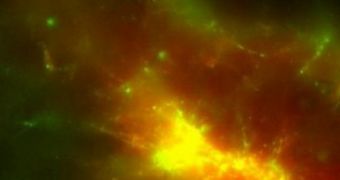Researchers at the Oxford University announce that they were recently able to create a nanoscale transport network that is capable of assembling itself. The network is traveled by molecular shuttles featuring very tiny motors, and is controlled by genetic instructions in DNA snippets.
The science team behind the network says that this study may pave the way for a variety of other self-assembling systems at the nanoscale, which could be used in fields as diverse as medicine, nanotechnology, and electronics.
Working together with colleagues at the Warwick University, the Oxford scientists demonstrated that their new nanoscale network was able to build its own tracks, and then disassemble them when they are no longer needed. Tracks several tens of micrometers were achieved in this demonstration.
Adam Wollman, a professor in the Oxford Department of Physics and the leader of the research, says that this proof-of-concept demonstrated that fluorescent green dyes could be easily transported from one section of the network to another, via nanoscale shuttles.
Details of the investigation appear in a recent issue of the top scientific journal Nature Nanotechnology. The study was supported by the Biological Sciences Research Council and the Engineering and Physical Sciences Research Council, e! Science News reports.
The tiny network is built from DNA and is powered by kinesin. This small protein, which is fueled with ATP (adenosine triphosphate), can propel the shuttles along tracks in the network with relatively high speeds.
“DNA is an excellent building block for constructing synthetic molecular systems, as we can program it to do whatever we need. We design the chemical structures of the DNA strands to control how they interact with each other,” Wollman explains.
“The shuttles can be used to either carry cargo or deliver signals to tell other shuttles what to do,” he goes on to say. One use for this system would be as a catalyst for chemical reactions, where the shuttles would carry chemicals to the center of a container at high speeds.
This technology is still in its infancy at this point, but the research team believes that it will eventually be used for numerous applications, some of which are not even hinted at today.

 14 DAY TRIAL //
14 DAY TRIAL //